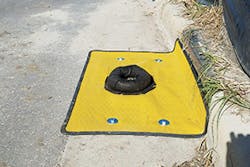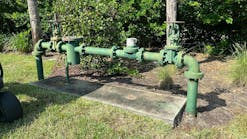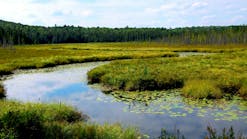If a stream or other waterbody is showing an increase in sediment or pollutant contamination, nearby active construction sites are usually the first suspect. As any developer or construction crew chief knows, devices to stop runoff from the site are an absolute necessity.
Construction disturbs soil and frees it to run into nearby storm drains or waterways. Trucks and other equipment swarm all over any construction site, often releasing hydrocarbons to contaminate the site. When a rain event hits, the rain will carry any loose soil and pollutants to the nearest storm drain, along with anything else that is not tied down, such as plastic and paper trash. If an inspector finds these items leaving the construction site, a big fine can be issued.
Those in charge of construction sites, whether homebuilding or road construction and repair, do not want to spend the money to install permanent inlet protection devices where they will not be needed once construction is finished. Temporary inlet protection devices meet the requirements to contain sediment and pollutants without the cost of permanent structures. Bag grate covers, wattles or other tubular devices, and silt fences can all be placed on one site, used until the work is finished and the site stabilized, and then removed. These devices can work in conjunction to provide the inlet protection needed—for example, wattles where lighter coverage is needed, silt fences for a perimeter, and grate covers and heavy wattles for curb inlets, storm drains, and in heavy runoff spots. Other BMPs such as erosion control blankets and permanent structures can finish out the plan. Once the devices are removed, they can sometimes be cleaned and used at another site, reducing costs.
The GR8 Guard units are installed over the grated storm drains, eliminating the need to remove the grate to install a device underneath. The GR8 Guard has a berm that forces water to rise at least 1.5 inches so that larger particles settle on the outside of enclosure. The device inside the square filters the water, keeping it out of the grate and the storm drain system. The units are attached to the grate with rebar tie-wire.
Once the GR8 Guard units were in place, the slopes were stabilized with rolled erosion control blankets and hydroseeding.
This part of California is seeing frequent enforcement of stormwater and sediment control requirements in public works and private sector projects. Construction-site inspections are completed frequently, so a system that works well is crucial to avoid noncompliance fines.
So far, the GR8 Guard devices are performing in an outstanding fashion. In January 2017, the area got a record 18.96 inches of rain, adding to total of 37.38 inches since October 2016. This is more than an inch greater than average annual precipitation. The filters kept sediment out of the storm drains and remained in place with no problems. The slopes are now stabilized and the GR8 Guard have been removed and reused in other locations.
“We recommend installing ERTEC Top Guard drain inlet devices prior to any construction activities,” says Daveggio. “We have 100% confidence in their products. We have never had any failures and they are very easy to maintain versus alternative devices.”
Southern California Sediment and Pollutants
A transfer station manager in southern California is using products from Filtrexx Sustainable Technologies to solve problems with sediment and pollutant runoff from the company’s location.
The company set up a treatment train using catch basin inserts, both single and dual, depending on the size of the catch basin. It installed Filtrexx StormExx units to capture pollutants as well as total suspended solids (TSS). The rest of the treatment train includes trash screens, daily surface sweeping to remove excessive dirt left by heavy traffic, and policing areas for trash.
StormExx is a catch basin insert that fits any existing storm drain system. Both round and square units are available in a variety of sizes. The replaceable cartridge is placed inside the storm drain so it is not visible or in the way at street level. StormExx uses the Filtrexx Mesh and Filtrexx Media, as does Filtrexx EnviroSoxx.
The unit captures trash, gravel, and debris and contains it in a housing inside the catch basin. The filter cartridge is suspended inside this housing and removes sediment and pollutants. Filtrexx Mesh is available with different opening or hole sizes, tensile strength, longevity, and materials, depending on the needs of the site. The mesh can be made from a variety of materials, including polypropylene, polyethylene, and natural fibers. The Filtrexx Media inside the cartridge captures up to two-thirds of the sediment, as well as removing pollutants.
These permanent BMPs were accompanied by the use of Filtrexx PetroLoxx devices as needed. Oil and grease are common in runoff from transfer stations because of heavy truck traffic. One goal is to prevent these pollutants from leaving the site. Along the curb of the transfer station, PetroLoxx devices were lined up with trash collecting fences to ensure that trash and pollutants are captured.
After installation of both permanent devices and moveable ones and careful attention to the other elements of the treatment train, the transfer station manager reports that he’s seen significant decrease in both sediment and pollutants coming off the site during storm events. TSS levels were reduced to 45 mg/L, well below the industrial permit benchmark of 100 mg/L. Oil and grease levels have also been below benchmarks standards.
More stringent stormwater regulations in the region and new sampling requirements compel companies such as the transfer station to find the BMPs that match their needs. The transfer station manager says his company regards water-quality and watershed protection as a high priority, leading to the best treatment train that can be employed.
The site receives regular inspections, including monthly ones from the local municipal inspectors and annually by the State Water Board. To stay in compliance, maintenance of the BMPs is extremely important. Sediment and trash removal around the filter socks, as well as inspection of the StormExx cartridges, occurs regularly as well as after storm events. Water samples show how well the treatment train is working and whether an increase in the number of BMPs or a change in positioning is needed. The area has experienced significant heavy storm events in the past year. The system has performed exceptionally well, despite the amount of rain.
The transfer station manager had some recommendations for anyone working on a similar site: “Know the watershed you are in and what specific contaminants, if any, are associated with it,” he says. Know the flow characteristics of the stormwater leaving your site, especially after storm events, and be ready to make changes to your BMPs as needed. Make sure that your water-quality samples are representative of the site and are handled with good laboratory procedure. If the lab samples show an increase in contaminant levels, check all filters and replace or reposition BMPs as needed.
Another suggestion is to create a pollution prevention team that is well trained and accountable. They should have knowledge of the correct BMPs for the site and how to deploy the products in the most effective way. Regular inspections and maintenance must be scheduled and extra ones done after storm events.
North Carolina Construction
BMP Construction, an erosion control services company working in the Wilmington, NC, area, is contracted to America’s largest homebuilder, D. R. Horton. The neighborhoods under construction range from 20 to 300 homes.
Because all of the sites worked on by the company are new and existing construction, BMP Construction owner Kenny Green knows the necessity of temporary inlet protection. He described the construction sites where the company works as sometimes having sandy soil and sometimes clay, so they needed devices that can handle any soil conditions. A number of feeder streams and creeks around these neighborhoods flow into the Cape Fear River and the Intracoastal Waterway. Inlet protection is crucial to protect these waterways. Green notes that regulations in the cities and states are getting tougher, so effective BMPs are more important than ever.
Green has used a variety of erosion and sediment control measures, including silt fences and inlet protection devices. He also installs straw wattles, straw matting, and biologs on certain sites. For inlet protection on these construction sites, he is using a recently introduced device, the GrateGator HD, from ACF Environmental of Richmond, VA.
The GrateGator is attached to a stormwater grate with toggle bolts. The grate does not have to be lifted out to be fitted with GrateGator, and the unit is lightweight, meaning less chance of injury for workers and faster installation. The high-flow filter is rated to handle 100.6 gpm per square foot, which is a higher flow rate than many alternatives. The device filters out sediment and contaminants. An overflow hole in the middle of the filter allows some water to escape during very heavy storm events, although the high flow rate ensures that the overflow will not happen very often.
The units have a reinforced base for extra durability and can be cleaned and repositioned easily. Because they are temporary, Green moves them from site to site as needed and they are easy to remove, clean, and reinstall.
Green says he relies on these products because at all the sites, temporary inlet protection is used and maintained until the lots are landscaped or the soil is stabilized. The devices must be properly maintained. “If you maintain your temporary devices the way you are supposed to, you will have great results out of them,” he says, adding that his advice would be to not corners, install the proper BMPs, and keep them maintained. “A lot of the time when a BMP product fails, it’s because it’s not being maintained. Maintenance is just as important as installing the product to start with.”
Some of the construction companies that BMP Construction works with hire outside firms to do inspections weekly and after storm events. State and city inspectors usually conduct inspections every two to three weeks and after heavy rains.
The GrateGator HD units placed by BMP Construction faced a real test in October 2016. Hurricane Matthew dumped massive amounts of rain in coastal and inland areas of North Carolina. The Wilmington area received at least 18 inches of rain in a short time, and stormwater systems were tested to the limit. BMP Construction had installed 15 to 20 GrateGator HD devices just before the hurricane. Green says they captured sediment before it entered the catch basins. Overall, they performed even better than expected under these severe conditions.
Sediment Control for the Army
Bell’s Seed Store in Fayetteville, NC, has supplied inlet protection products to Ft. Bragg for use in new and existing construction projects since 2009. One of the mainstays is GeoHay from GeoHay LLC based in Boiling Springs, SC.
GeoHay products are made from recycled carpet, keeping that heavy waste out of landfills. The carpet is formed into 9-inch cylinders, available in 4- to 20-foot lengths. Other sizes are 12, 15, and 18 inches in diameter. The cylinders absorb pollutants and capture sediment. In testing, the GeoHay products had an 85% sediment capture rate and at least 93% removal of oil. They also remove total suspended solids and heavy meals.
Bell’s obtains the GeoHay products from L&M Supply Co. of Willacoochee, GA. L&M’s vice president for business development, Jerry Kallam, says the heavy weight of the GeoHay in comparison to straw or wood wattles allows the contractor to use them on an asphalt or concrete surface with a lower chance of movement during rain events. They can also be placed along curb inlets or on bare dirt areas.
Kallam notes that GeoHay products are often used in conjunction with US Erosion Control products, also supplied by L&M. “We have installed our US Erosion Control products under the GeoHay to prevent scouring from the stormwater running on the outside of the GeoHay. The wood fiber wattles from US Erosion Control are also used in lighter-flow areas and the GeoHay in the concentrated flow.” Kallam compares the combination to “peanut butter and jelly.”
He adds that the GeoHay can be used in conjunction with permanent inlet protection structures to provide some sediment control before sediment accumulates enough to block the permanent structures.
These products also got a good test during Hurricane Matthew. Bell’s Seed Store is located about a mile from the Cape Fear River. The hurricane brought tremendous flooding and heavy runoff to the store site. Owner Stewart Bell placed GeoHays on his property to stop trash and sediment from reaching the river from his location. He was very pleased to see how effective they were, and now he can use his own experience as an example to future customers.
Kallam believes that stormwater regulations will continue to increase; he notes that more stringent regulations were first implemented in California and the rest of the West Coast and then came to the eastern states.
In the area that L&M Supply Co. services, stormwater inspectors are monitoring active construction sites weekly or more often depending on rain events.
Recommendations
The people interviewed for this article offered recommendations for anyone planning to install temporary inlet protection devices.
- Make sure you know what the sediment and pollutant control requirements are for the area where your project is located.
- Choose the right products. If you need ideas, talk to a couple of distributors and learn what their various products can do.
- Plan a connected treatment train. You might need silt fences, curb inlet protectors, wattles, and other products to work together.
- Installation is critical, so make sure that the installers completely understand what they need to do and be sure to check once installation is complete.
- Check the installed BMPs soon after installation to ensure that they are operating as you planned. Make any changes that are needed.
- Inspect the system regularly and especially after heavy rains.
- Maintenance is vital for success. Plan a regular maintenance schedule, even for the temporary products, and adjust the schedule if a problem comes up.
- When the project is finished, remove the devices and, if they are undamaged and still usable, install them at your next site.








